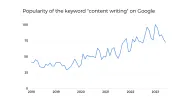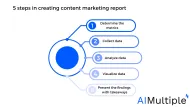Top 10 Content Writing Best Practices in 2024
Companies hire content writers for web content writing, product descriptions, company profile texts, or e-mails as part of their content marketing strategy. Yet, more than 30% of marketers struggle to create content that attracts their audience and resonates with them well, and 60% of B2B content marketers have difficulty creating high-quality content.1,2
Learn about ten content writing tips to stand out in the market.
What is content writing?
Content writing is a general term that covers all kinds of content produced by writers and includes different content, such as
- E-mails
- Whitepapers
- RSS feeds
- Newsletters
- Website or blog posts
- Landing pages
- Company profile texts
- Product descriptions.
Why do companies hire a content writer?
- To create content that educates the readers with a comprehensive review of the market or their services.
- To increase their presence on search engines or social media.
By attracting readers, companies increase their visibility, rankings on search engines, and brand reputation, which is reflected in sales. There are some content writing practices in that high-quality content can help you grow your business.
Top ten content writing best practices
1- Determining focus keywords
While searching on the Internet, customers use specific keywords that correspond to their query to get knowledge on that specific service or product rather than reading a blog post on some unrelated topic.
That’s why focusing on one topic with specific keywords at a time can help produce much more consistency within the content without going beyond the subject, makes the keyword research process easier, and helps grab the reader’s attention with relevant content.
2- Content personalization
A recent survey reveals that customer centricity and personalization are the most important goals of companies in their digital transformation process, but only a few achieve personalization in content writing.3 The success rate of digital transformation in marketing is around 30%, while the remaining 70% needs to catch up in implementing strategies.4
Check our article to learn more about digital transformation challenges and some solutions.
3- Publishing consistently
When it comes to content publication, although content writing skills are crucial, consistency is the key. 57% of marketers say they have attracted new customers by consistently publishing web content.1 Marketers state that publishing 2-4 pieces of content per week would allow companies to keep track.5
4- Editing and updating content regularly
Source: Semrush
Figure 1. A survey on the returns of updating content
Just as sharing content regularly, updating the old ones is crucial to stay relevant and to rank high on search engines. However, findings show that the rate for updating older articles is around 40%, making the remaining 60% outdated content.1
5- Adding visual content
As there is an accumulation of web content on the Internet, customers are selective in what to read. Indeed, articles with visual content have 94% more clicks on search engines, placing images at the very heart of the engaging content writing process.1
However, adding irrelevant visual content to the articles would provide no benefit and even harm the brand’s reputation. Creating relevant and informative visual content with alt texts can help readers find the content easier on search engines and ensure brand reputation.
Check our article to learn how to transform data into images anyone can get insights through data visualization.
6- Having a data-driven approach
Source: Hubspot
Figure 2: What percentage of companies have a data-driven approach in decision-making processes?
Research shows that more than 80% of professionals do not have a high degree of data literacy, and only half of companies use a data-driven approach in their decision-making processes.6
Although every writer has their own point of view, writing style, or experiences to tell the readers, an intuitively-driven approach does not provide a solid or objective picture to the target audience. Unlike the intuitively-driven approach, which is subjective, a data-driven approach based on research and factual knowledge can make the content more trustworthy.
7- High user/content readability
Explaining a phenomenon with simple words is the key. To increase the readability of content, it is crucial to have clear language. However, creating simple content should not mean a lack of depth. It is suggested that content with 1,000+ words is the most read; thus, long-form content seems desirable.7
Besides using simple sentences and clear language, providing a table of content at the beginning of the texts to inform the readers whom the article is targeting and why it is written, splitting the content into paragraphs, and adding bullet points can help increase the readability.
We have also checked AIMultiple’s all-time top 100 most-read articles and found that the average word count of our top 100 articles is around 2600 words. As the shortest article has around 1000 words, the largest one has 5000+ words.
8- Consistency in the voice tone
Do you prefer to interact with the readers using formal or informal language? Determining a tone of voice that overlaps with the corporate identity for all the written content and using it consistently can help the readers have a consistent brand image.
9- Using tools to rank high on search engines
To decide whether your content is high-quality, you need the readers first. However, 94% of customers click only on the first page when they search for a product or service.8 That’s why using Search Engine Optimization (SEO) tools helps write content that can get a high search volume and attract more readers.
10- Getting help from the social media
Sometimes content writers can have writer’s block, and creating content can be stressful. In such cases, getting help from social media trends or marketing strategies can give the writers ideas on narrowing down the topic they are interested in.
Here, we also provide our data-driven list of content-writing services.
If you need any assistance in content writing, do not hesitate to contact us:
External Links
1- Ouellette, Coral (April 22, 2022). “Ultimate List of Blogging Statistics and Facts (Updated for 2022)”. Optinmonster. Retrieved November 16, 2022.
2- Salkin, Miné (March 29, 2022). “40+ Content Marketing Statistics to Power Your 2022 Strategy”. Semrush. Retrieved November 16, 2022.
3- Palumbo, Silvio; Simon, Mario; Cornock, Will; George, Chris; Shoji, Yohei (October 5, 2021). “AI Has Launched a $200 Billion Revolution in Content Personalization”. BCG. Retrieved November 16, 2022.
4- “Digital Transformation.” BCG. Retrieved November 16, 2022.
5- Brenner, Michael (November 15, 2022). How Often Should You Blog? [Blog Post Frequency Research]. Marketing Insider Group. Retrieved November 20, 2022.
6- The Data-Driven Mindset 2019 Research (PDF). HubSpot. Retrieved November 20, 2022.
7- Brenner, Michael (March 9, 2022). How Many Words Should a Blog Post Be? Marketing Insider Group. Retrieved November 20, 2022.
8- Sharma, D., Shukla, R., Giri, A. K., & Kumar, S. (2019, January). A brief review on search engine optimization. In 2019 9th international conference on cloud computing, data science & engineering (confluence) (pp. 687-692). IEEE.

Cem has been the principal analyst at AIMultiple since 2017. AIMultiple informs hundreds of thousands of businesses (as per similarWeb) including 60% of Fortune 500 every month.
Cem's work has been cited by leading global publications including Business Insider, Forbes, Washington Post, global firms like Deloitte, HPE, NGOs like World Economic Forum and supranational organizations like European Commission. You can see more reputable companies and media that referenced AIMultiple.
Throughout his career, Cem served as a tech consultant, tech buyer and tech entrepreneur. He advised businesses on their enterprise software, automation, cloud, AI / ML and other technology related decisions at McKinsey & Company and Altman Solon for more than a decade. He also published a McKinsey report on digitalization.
He led technology strategy and procurement of a telco while reporting to the CEO. He has also led commercial growth of deep tech company Hypatos that reached a 7 digit annual recurring revenue and a 9 digit valuation from 0 within 2 years. Cem's work in Hypatos was covered by leading technology publications like TechCrunch and Business Insider.
Cem regularly speaks at international technology conferences. He graduated from Bogazici University as a computer engineer and holds an MBA from Columbia Business School.
To stay up-to-date on B2B tech & accelerate your enterprise:
Follow on

Comments
Your email address will not be published. All fields are required.